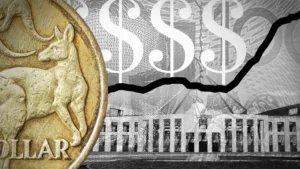Home » Commentary » Opinion » How to reverse Whitlam-sized growth in government
· Australian Financial Review
 The day before news broke that inflation had surged to 5 per cent, the Australian Bureau of Statistics reported that federal, state and local governments collectively had spent $876 billion in 2020-21, representing 42.4 per cent of gross domestic product.
The day before news broke that inflation had surged to 5 per cent, the Australian Bureau of Statistics reported that federal, state and local governments collectively had spent $876 billion in 2020-21, representing 42.4 per cent of gross domestic product.
Although as significant as the surge in inflation – and not unrelated to it – this alarming figure largely managed to dodge the spotlight.
Before the coronavirus pandemic, Australia’s government sector was around 35 per cent of GDP and levels above 40 per cent were confined to the big welfare states of Europe. Is Australia joining that club?
The rise in government spending in 2019-20 and 2020-21 lifted its share of GDP by seven percentage points. The only other similar episode in Australia’s post-war economic history was the two-year jump in federal government spending by six percentage points of GDP under the Whitlam government in the 1970s. On that occasion, the expansion was never reversed.
A reversal is more likely this time, as the pandemic-related spending – such as that on JobKeeper – was clearly temporary. At the same time, however, there are strong upward pressures in several major programs that may prevent government spending from going back to its pre-pandemic size.
This matters greatly to the outlook for public debt, the size of the tax burden and the economy’s dynamism.
Looking at the federal spending that dominates the public sector, the recent budget points to payments declining from the peak of 31.6 per cent of GDP in 2020-21 to 27.1 per cent by 2023-24 and then settling around 26.5 per cent all the way out to 2032.
However, this decline masks a longer-term upward trend from the average of 24.5 per cent since 2000, excluding years in which spending was inflated by responses to the global financial crisis and the pandemic.
Projections out to 2032 are likely to be an understatement. But even if correct, they would imply spending remaining about 2 per cent of GDP higher than in “normal” years since 2000. This is a major contributor to the structural budget problem.
These are inconvenient facts in the federal election campaign, in which the bipartisan position is that the federal budget will be manageable without expenditure savings or tax increases and that there is even room for new spending promises.
The past provides a better guide to how the future might look. In 2013-14, then treasurer Joe Hockey declared that the age of entitlement was over. Developments since then are instructive. The savings Hockey sought in the 2014-15 budget proved elusive and the culture of entitlement has only strengthened its grip on government expenditure policy.
In the 10 years from 2013-14 to the 2023-24 forward estimates, federal outlays grew by 4.7 per cent a year in nominal dollar terms, compared with GDP growth of 4 per cent.
The budget bottom line is highly sensitive to even small changes in the growth rate of spending. Had spending grown at the same rate as GDP (4 per cent) over the 10 years from 2013-14 instead of 4.7 per cent, it would be some $30 billion lower in 2023-24.
The 10-year record shows how a small sub-set of fast-growing federal budget programs pushed the growth of spending above GDP.
These are defence, aged care, childcare subsidies, grants to the states for schools and public hospitals (all with annual growth rates of 7-9 per cent) and the NDIS, which has gone from almost nothing to $39 billion in the 10 years to 2023-24 (offset to a small degree by the absorption of pre-existing disability care programs).
These programs comprised 17 per cent of Commonwealth expenditure in 2013-14 but account for half the increase in the ensuing 10 years. As a group they grew by 10 per cent a year for 10 years, compared with 5 per cent for the pass-through of GST collections to the states and 3 per cent for all other Commonwealth programs collectively.
This is not to suggest that all expenditures should grow at the same rate. But the fastest growing programs are an obvious place to start the search for ways to slow the growth of spending.
The demands in all these areas of spending are manifest. But unless programs are reformed and better results achieved for the same or less spending, the structural budget problem will persist.
Nowhere is this need more apparent than in the out-of-control NDIS, now heading for a $64 billion price tag by 2030. In the latest demonstration of the entitlement culture, some crossbenchers are demanding the scheme be expanded to include over-65s.
If this kind of thinking and the broader entitlement attitudes persist, we can forget about the government sector ever returning to 35 per cent of GDP, let alone anything smaller.
How to reverse Whitlam-sized growth in government